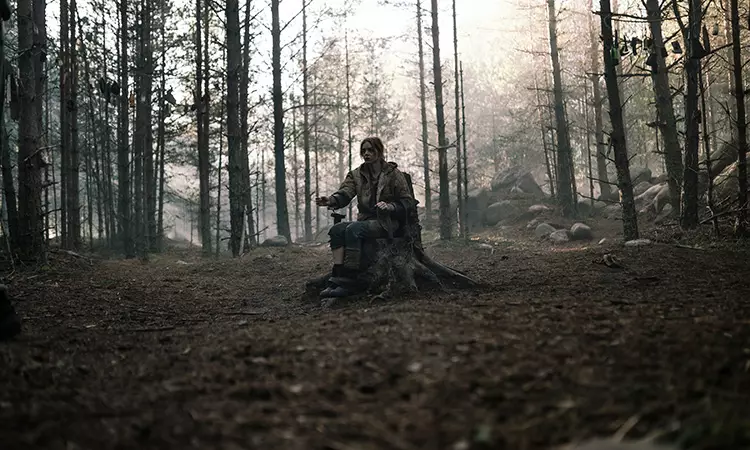In the cinematic world, few premises are as engaging as those intertwined with apocalyptic scenarios, particularly when religion shapes the narrative. E.L. Katz’s film, “Azrael: Angel of Death,” crafted by Simon Barrett, tantalizingly explores the remnants of society after a cataclysmic event dubbed the Rapture. The story begins with a telling phrase, “Many years after the Rapture,” plunging audiences into a dire and altered existence that is not only post-apocalyptic but distinctly post-religious in its implications. This framing is crucial, as it dictates a mindset of survival affected by an eerie cultural regression, one that splices humanity’s ancient reverence for spirituality with its primal instincts to endure.
The film opens within a grim, candle-lit church, setting a tone of somber reflection on lost faith. The church, now a fixture of a ravaged world, is marred by distinct imagery—its wooden walls contain an unsettling fissure that spills forth symbols both grotesque and intriguing. This conflation of themes sets the stage for the intersection of femininity and grotesqueness within a religious space, where hope is corrupted, and spiritual leaders mirror a far more sinister reality. Here, the priestess, a heavily pregnant matriarch, leads a community desperate to ward off both external and internal darkness, resorting to human sacrifice and vile acts that evoke primal fear.
Significantly, the film opts for a stark communication style. The use of English is scant, with onscreen titles and a single Spanish-speaking character reflecting a profound disconnection between cultures and ideas. “Driven to renounce their sin of Speech,” the community illustrates how dire circumstances can force societies to regress to primal forms of communication—grunts, gasps, and inarticulate sounds become the norm. The surreal aspect is compounded by the characters’ possession of modern artifacts like rifles and cars, juxtaposed with their return to pre-modern, mystical thinking. These elements question not only the survival of language but the essential nature of communication in a world stripped of societal constructs.
At the core of the plot resides Azrael, a young woman portrayed by the talented Samara Weaving. Following her abduction with her lover, Azrael metamorphoses from a victim into a figure of vengeance, reflecting the instinct for survival as she navigates threats intrinsic to her environment. The depiction of her struggle transforms into a narrative steeped in visceral intensity, painting the wilderness as both friend and foe—a dangerous entity that challenges her strength while simultaneously nurturing her resolve to confront dark forces.
However, while survival is a palpable theme, the film’s religious subtext cannot be easily ignored. Imagery reminiscent of crucifixion and resurrection punctuates the storyline, reframing hope into a twisted reality where divine figures are repainted as harbingers of dread. The juxtaposition between angelic ideals and infernal realities prompts audiences to ponder the film’s true protagonist—was Azrael, whom viewers root for, a savior or the embodiment of the Antichrist? This moral ambiguity is a deliberate device, unraveling in layers as the narrative progresses, challenging the audience’s instincts and beliefs regarding good and evil.
The portrayal of a world turned hellish further solidifies the film’s critique of societal structures that fail when faced with apocalypse. It invites contemplation about what remains when traditional beliefs crumble: perhaps a new form of fidelity to darker motives is born from the ashes of spirituality. Azrael’s journey becomes a testament to embracing the chaos and decay, suggesting that survival might best unfold through unshackling from the chains of dogma.
In “Azrael: Angel of Death,” the exploration of themes dauntingly reflects today’s polarized reality. It interrogates the subjective nature of faith and morality in a world beset by despair, unbeknownst to its inhabitants. As they traverse landscapes fraught with decay and desperation, it becomes increasingly challenging to distinguish between the sacred and profane. Ultimately, the film asks profound questions that resonate with audiences, forcing them to evaluate not just the narrative but their compass in a world that, similar to Azrael’s, often seems to drift towards a fiery end, igniting debates on faith, survival, and the human condition.

